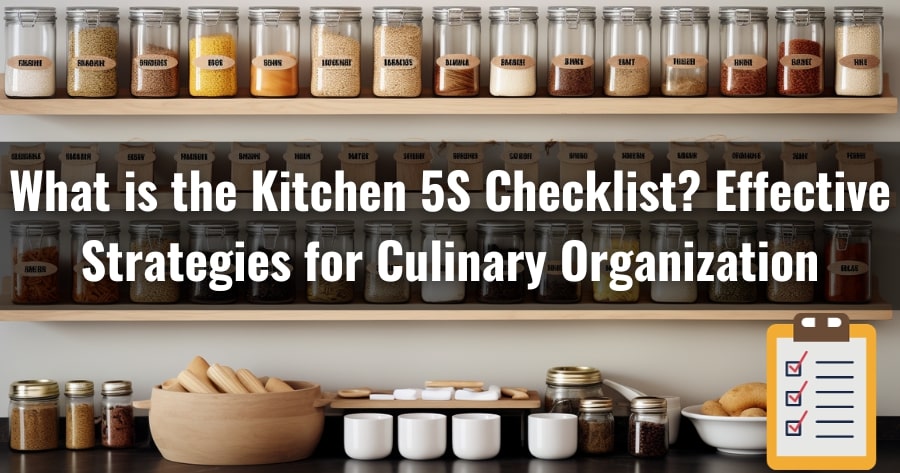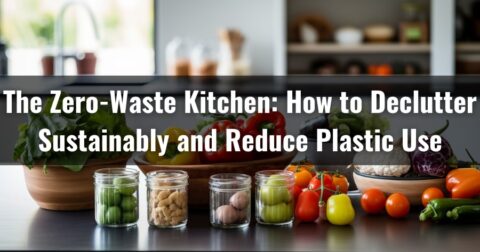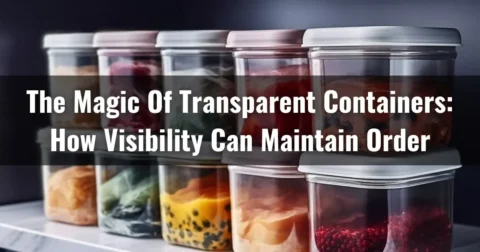A well-organized culinary area facilitates efficient and enjoyable cooking, and some effective methodologies referred to as “5S” help in this regard. Incorporating the kitchen 5S checklist can help create a streamlined and functional space, making it easier to find tools and ingredients while reducing clutter and waste.
This methodology comprises five fundamental phases, namely: Sort, Set in Order, Shine, Standardize, and Sustain. The term “Sort” refers to the first phase of the process, which involves decluttering and prioritizing items, eliminating unnecessary gadgets, and creating space for essential tools.
In the “Set in Order” phase, optimizing item placement for efficiency, categorizing, and strategically positioning kitchen tools are the main goals.
We will discuss in detail what the Kitchen 5S Checklist entails, its benefits, and how you can implement it in your own kitchen.
Jump to Section
Implementing 5s Audit Checklist: Enhancing Organization and Efficiency in Kitchen
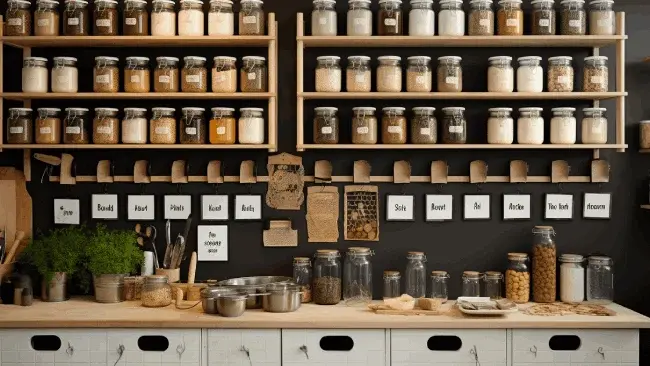
To enhance organization and efficiency in your cooking area, you can follow the Kitchen 5S Checklist, which includes the following:
1. Sort: Declutter and Prioritize
The first phase of the kitchen 5S checklist is “Sort,” which focuses on decluttering and prioritizing items in your kitchen. To effectively implement the “Sort” phase, start by thoroughly assessing all the items in your kitchen and systematically evaluating each item’s necessity.
Consider whether an item contributes to the overall functionality of your kitchen and whether it is frequently or occasionally used. Group the items into three categories: keep, discard, or reorganize. Discard broken or obsolete items that no longer serve a purpose in your kitchen.
For occasional-use gadgets or sentimental items, our suggestion is that you consider storing them separately. You lay the foundation for an organized and efficient culinary workspace by prioritizing functionality and decluttering your kitchen.
2. Set In Order: Optimize Placement for Efficiency
As part of the kitchen 5S checklist, the second phase is “Set in Order,” which emphasizes optimizing the placement of items to enhance efficiency. It involves placing kitchen tools close to their point of use, clearly labeling ingredients, and simplifying the flow path to make cooking easier.
To effectively execute the “Set in Order” phase, focus on categorizing your kitchen tools and utensils after decluttering. Group similar items, such as baking tools, cooking utensils, dishes, glassware, and occasional-use items.
Once items are grouped, decide where each category should be stored based on frequency of use and proximity to relevant work areas. For example, place frequently used cooking utensils close to the food preparation area for easy access.
Clearly label ingredients and items to avoid confusion and mistakes during meal preparation. Simplify the flow path in your kitchen to create a smooth workflow and reduce the time and effort spent searching for items.
By optimizing the placement of items, you improve efficiency and contribute to a visually appealing and well-organized kitchen.
3. Shine: Prioritize Cleanliness
“Shine,” the third phase, underscores the significance of cleanliness in your kitchen. Regularly emphasizing the cleanliness of your kitchen helps prevent foodborne illnesses and maintains a hygienic environment.
This phase goes beyond just tidying up; it promotes a proactive approach to cleanliness that becomes an integral part of your cooking routine.
Consider incorporating habits that will reduce the need for extensive cleanup after cooking. Clean as you cook, wiping down surfaces and utensils to minimize the accumulation of grime. This keeps your workspace tidy and reduces the time spent on post-cooking cleaning tasks.
In terms of the cleaning order, establish a systematic routine. Begin by dusting the tops of cabinets and the refrigerator, ensuring that neglected areas are addressed regularly.
Clean small appliances, such as toasters and blenders, to prevent the buildup of food residues. Next, focus on the items on your countertops, wiping them down thoroughly. Scrub the exterior of the stove and oven, paying attention to any spills or stains.
Addressing the sink is a necessary step in maintaining kitchen cleanliness. Deep clean the sink regularly to prevent the growth of bacteria and eliminate unpleasant odors.
Clear out the kitchen storage, discard expired items, and wipe down shelves and drawers with a vinegar and dish soap mixture. Pay attention to the exterior of large appliances, ensuring they are free of fingerprints and spills.
As part of a comprehensive kitchen cleaning routine, emptying and wiping down the garbage can is essential. Finish the cleaning process by sweeping, vacuuming, and mopping the floor. Following a systematic cleaning order ensures that every part of your kitchen receives the attention it needs.
Also, replace sponges and towels regularly to prevent the spread of germs, light a candle for a pleasant aroma, and add fresh flowers for a finishing touch.
For deeper cleaning tasks, consider periodically addressing areas like the oven interior, exterior cabinet doors, pantry, and spaces underneath appliances. These tasks contribute to maintaining a spotless and organized kitchen.
4. Standardize: Establish Consistent Procedures
The Kitchen 5S Checklist for the “Standardize” phase focuses on establishing consistent procedures in your kitchen. To apply the concept of standardization, develop a set of guidelines for tasks like cooking, dishwashing, and overall kitchen maintenance.
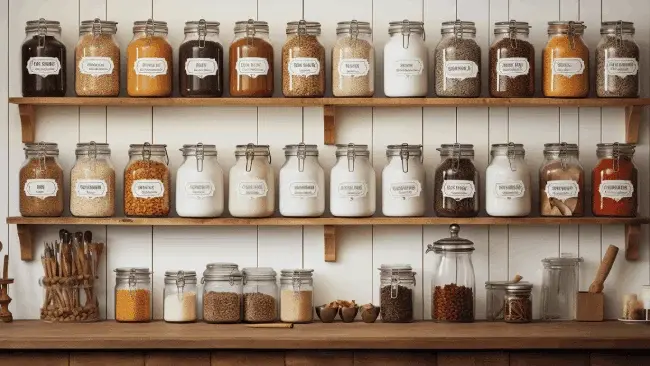
Clearly communicate these procedures to all household members, fostering a shared understanding of how the kitchen should be organized and operated. Ensure everyone knows and follows standard kitchen procedures.
Apply the concept of standardization to specific processes, such as dishwashing and manufacturing. Develop a standardized approach to dishwashing, specifying the order in which dishes are washed, dried, and put away.
This consistency helps maintain cleanliness and contributes to a smoother flow in the kitchen. Similarly, standardizing operations, such as meal preparation, ensures that each step is executed systematically and organized.
5. Sustain: Maintain Order Continuously
Now, the fifth phase, “Sustain,” is about maintaining order and organizing. Ensure that established standards are being maintained and emphasize continuous improvement.
This phase encourages a proactive approach to sustaining order, reminding you to assess and adjust your kitchen organization as needed regularly. It reinforces the idea that maintaining an organized kitchen is an ongoing process, not a one-time task.
Assign specific tasks and responsibilities to individuals and rotate them among family members to establish a culture of responsibility. This ensures that everyone actively participates in the upkeep of the kitchen, promoting a shared sense of ownership over the space.
Implement routine inspections to assess adherence to standards and identify any deviations or areas that need improvement. This proactive approach allows for timely corrections and adjustments, preventing the gradual deterioration of the organized state.
Regularly communicate with household members about the benefits of maintaining an organized kitchen, fostering a collective commitment to sustaining the established order. Encourage open communication and feedback to address any challenges or suggestions for improvement.
Adapt to changes over time by periodically reassessing the kitchen’s organization to accommodate shifting priorities, lifestyle changes, or new appliances. This flexibility ensures that the organization remains relevant and tailored to the specific requirements of the household.
Through a combination of ongoing commitment, shared responsibility, regular assessments, and adaptability, the “Sustain” process helps you keep your kitchen organized and efficient.
FAQ’s: What is the Kitchen 5S Checklist
Some common questions homeowners ask about kitchen organization. Here are some questions and answers to help you out:
How often should you reassess and adjust your kitchen organization?
We recommend you reevaluate and adjust your kitchen organization every three to six months or more frequently if things change a lot.
Conducting regular evaluations allows you to maintain an efficiently organized kitchen that aligns with your current needs and priorities.
During these assessments, pay attention to any areas that appear cluttered or inefficient. Take note of any new equipment or tools you have acquired and any changes in your cooking habits or dietary preferences.
Adjust your organization accordingly by reorganizing your cabinets, drawers, and pantry to optimize functionality.
What are considered smart storage solutions for efficiently organizing kitchen items?
To efficiently organize your kitchen items, start by implementing smart storage solutions. Adjustable shelving is a great way to accommodate items of various sizes, allowing you to make the most of your cabinet space.

Utilize pull-out or pull-down racks for easy accessibility to pots, pans, and pantry items so you can quickly find what you need.
Drawer dividers are perfect for keeping utensils and cutlery neatly organized, saving you time and frustration. Clear containers are also helpful, allowing you to identify the contents inside easily. Install hanging hooks or racks for frequently used cookware, freeing up valuable cabinet space.
Stackable storage solutions are a fantastic option for optimizing your kitchen space, while under-sink organizers can help keep cleaning supplies in order. These smart storage solutions will make your kitchen look more organized and enhance your overall cooking experience.
Conclusion
Implementing the Kitchen 5S checklist equips you with a powerful strategy to transform your culinary space into a haven of efficiency and order.
The systematic approach of Sort, Set in Order, Shine, Standardize, and Sustain provides a roadmap for decluttering, optimizing placement, prioritizing cleanliness, and maintaining order.
Regular assessments, open communication, and smart storage solutions ensure your kitchen is tailored to your evolving needs. Follow the 5S methodology, and watch your kitchen become a seamless and enjoyable workspace.


